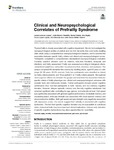Mostrar o rexistro simple do ítem
Clinical and neuropsychological correlates of prefrailty syndrome
| dc.contributor.author | Lorenzo-López, Laura | |
| dc.contributor.author | Blanco-Fandiño, J. | |
| dc.contributor.author | Cibeira, Nuria | |
| dc.contributor.author | Buján, Ana | |
| dc.contributor.author | López-López, Rocío | |
| dc.contributor.author | Maseda, Ana | |
| dc.contributor.author | Millán-Calenti, José Carlos | |
| dc.date.accessioned | 2020-12-14T12:34:44Z | |
| dc.date.available | 2020-12-14T12:34:44Z | |
| dc.date.issued | 2020-11-09 | |
| dc.identifier.citation | Lorenzo-López L, Blanco-Fandiño J, Cibeira N, Buján A, López-López R, Maseda A, Millán-Calenti JC. Clinical and neuropsychological correlates of prefrailty syndrome. Front Med (Lausanne). 2020 Nov 9;7:609359. | es_ES |
| dc.identifier.issn | 2296-858X | |
| dc.identifier.uri | http://hdl.handle.net/2183/26932 | |
| dc.description.abstract | [Abstract] Physical frailty is closely associated with cognitive impairment. We aim to investigate the neuropsychological profiles of prefrail and non-frail dementia-free community-dwelling older adults using a comprehensive neuropsychological evaluation, and to examine the association between specific frailty criteria and clinical and neuropsychological scores. Participants completed a comprehensive standardized neuropsychological evaluation (covering cognitive domains such as memory, executive functions, language and attention), and frailty assessment. Frailty was assessed according to biological criteria: unintentional weight loss, exhaustion, low physical activity, slowness, and weakness. The sample comprised 60 dementia-free community-dwelling adults, aged 65 years or older (range 65–89 years; 60.0% women). Forty-two participants were classified as robust (no frailty criteria present), and 18 as prefrail (1 or 2 frailty criteria present). We explored neurocognitive differences between the groups and examined the association between specific criteria of frailty phenotype and clinical and neuropsychological outcomes with bivariate tests and multivariate models. Prefrail participants showed poorer cognitive performance than non-frail participants in both memory and non-memory cognitive domains. However, delayed episodic memory was the only cognitive subdomain that remained significant after controlling for age, gender, and educational level. Gait speed was significantly associated with general cognitive performance, immediatememory, and processing speed, while grip strength was associated with visual episodic memory and visuoconstructive abilities. Both gait speed and grip strength were negatively associated with depressive scores. Our results suggest that prefrailty is associated with cognitive dysfunction. The fact that specific cognitive domains may be susceptible to subclinical states of physical frailty may have important clinical implications. Indeed, early detection of specific cognitive dysfunctions may allow opportunities for reversibility. | es_ES |
| dc.description.sponsorship | Xunta de Galicia; ED431C 2017/49 | es_ES |
| dc.description.sponsorship | Xunta de Galicia; ED431F 2017/09 | es_ES |
| dc.description.sponsorship | This work was supported by Xunta de Galicia (ED431C 2017/49, ED431F 2017/09). LL-L was supported by the Ramon y Cajal Postdoctoral Senior Grant (RYC-2015-18394) from the Spanish Ministry of Economy, Industry and Competitiveness, co-financed by the European Social Fund. JB-F was supported by a predoctoral grant from the Autonomous Government of Galicia (ED481A-2017/219), and the European Union (European Social Fund). | |
| dc.description.sponsorship | info:eu-repo/grantAgreement/MINECO/Programa Estatal de Promoción del Talento y su Empleabilidad/RYC-2015-18394/ES/ | |
| dc.language.iso | eng | es_ES |
| dc.publisher | Frontiers Media S.A. | es_ES |
| dc.relation.uri | https://doi.org/10.3389/fmed.2020.609359 | es_ES |
| dc.rights | Creative Commons Attribution 4.0 International License (CC-BY 4.0) | es_ES |
| dc.rights.uri | http://creativecommons.org/licenses/by/4.0/ | * |
| dc.subject | Aging | es_ES |
| dc.subject | Prefrailty | es_ES |
| dc.subject | Neuropsychologial assessment | es_ES |
| dc.subject | Gait speed | es_ES |
| dc.subject | Grip strength | es_ES |
| dc.title | Clinical and neuropsychological correlates of prefrailty syndrome | es_ES |
| dc.type | info:eu-repo/semantics/article | es_ES |
| dc.rights.access | info:eu-repo/semantics/openAccess | es_ES |
| UDC.journalTitle | Frontiers in Medicine | es_ES |
| UDC.issue | 7 | es_ES |
| UDC.startPage | 609359 | es_ES |
Ficheiros no ítem
Este ítem aparece na(s) seguinte(s) colección(s)
-
GI-GIGG - Artigos [113]
-
INIBIC-IX - Artigos [31]






